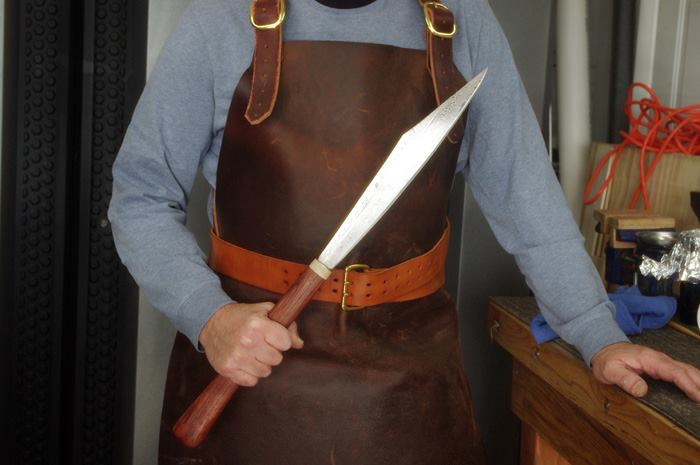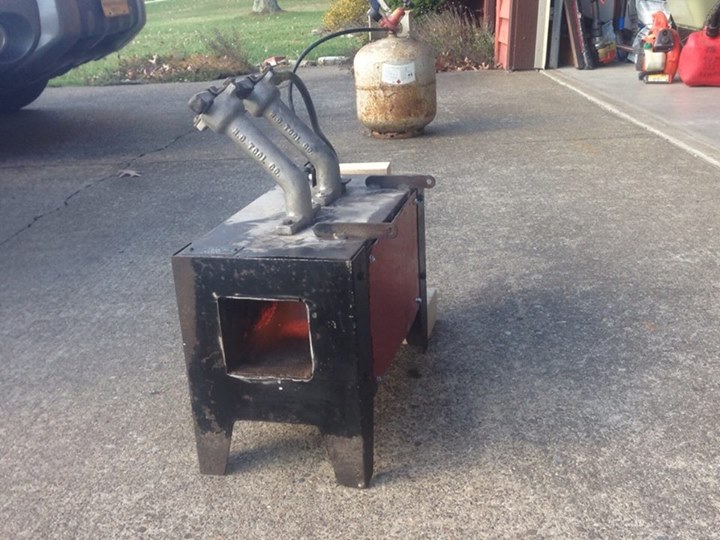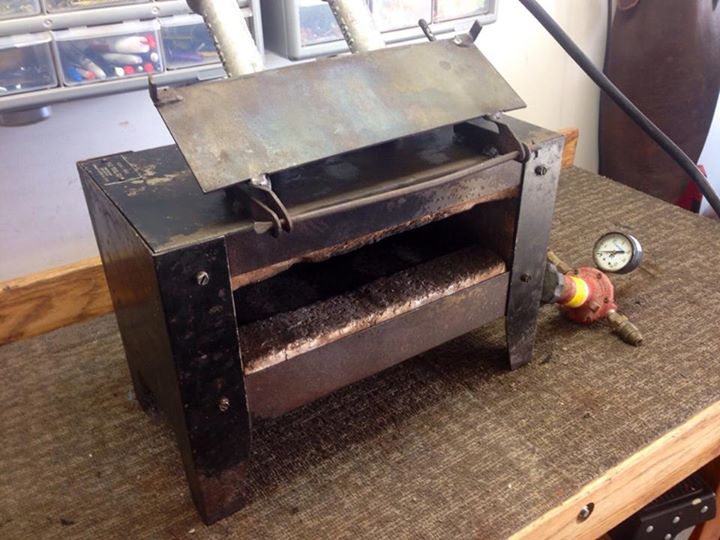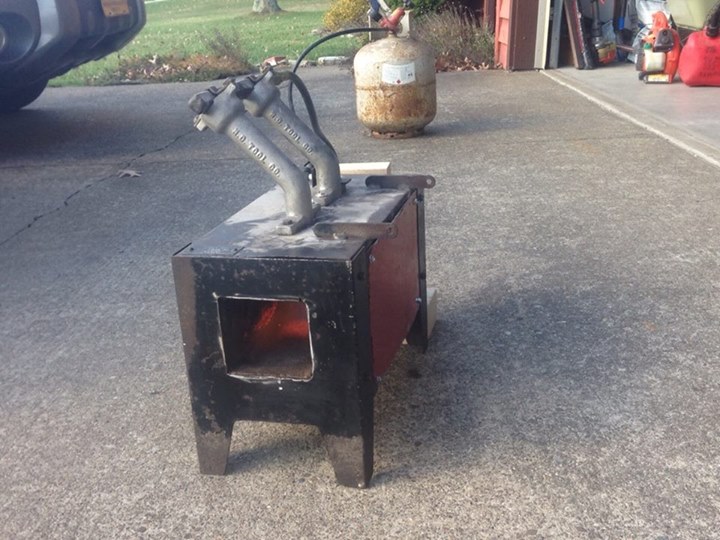
ytuyuty
Members-
Posts
114 -
Joined
-
Last visited
Content Type
Profiles
Forums
Articles
Gallery
Downloads
Events
Everything posted by ytuyuty
-
So, I took apart my forge, replaced a lot of the cracked lining with kaowool, and painted the inside with ITC-100. The gas line has a regulator that I can adjust from 0 to 15 PSI. The flame is blowing 6 inches out of both ends of the forge, and is bright yellow. I am getting a lot of scale forming on the steel. I tried to take photos of the flame outside of the forge, but it won't stay lit. Inside of the forge, you can't really see a flame to photograph, it's just a whirlwind of yellow and blue fire inside. Adjusting the cylinder valve and regulator valve has no effect on the color of the flame. What else can I do to get a more reducing flame, beside buying new flame nozzles?
-
-
LOL Yeah, I read that in several sources. The books also said to go ahead and make a knife anyway to get it out of your system! I'm currently making some tongs and Hardie tools, and modifying my hammers, and will get back to making blades when I feel that I am better prepared. Already straightened a coil spring in anticipation....
-
Thanks! Scale got mixed into the blade Had to grind the blade too thin as a result Blade shape turned out wrong Couldn't forge the blade shape, had to grind it, and even then it came out wrong Handle is wrong shape Bolster doesn't fit flush Bolster has a gap around the tang Pommel cap is off center etc.
-
Newbie here. I saw this 15th Century ballock dagger with a black handle that spoke to me. I had to make one! So I bought a gas forge, some hammers and an automobile leaf spring from the junkyard. Here is my first forging attempt, a knife. It was a disaster. C'est la vie, I learned a lot and look forward to trying again after a get more experience. Multi-stage edge and reinforced point Full tang peened over a bonze pommel cap Boxwood handle
-
60 layer pattern welded sword (photo heavy)
ytuyuty replied to kayakersteve's topic in Swordsmithing
Nice- 16 replies
-
- union forge
- bladesmith
-
(and 1 more)
Tagged with:
-
No worries Mikey, I appreciate the input. I just ordered some ITC-100 so it looks like tuning the burner is the way to go. Thanks all, photos of the dragon's breath coming soon.
-
Thanks I should have been more specific with my question. I am making steel knives using spring steel. My forge is new to me and I am still not entirely comfortable with my ability to differentiate between a reducing vs. oxidizing environment. My friend's gas forge produced a lot of scale, I hope to avoid that. Appreciate the input.
-
Is that an opinion or expert opinion or based on evidence? Thanks
-
Is there any benefit to throwing some charcoal into a propane forge to "enrich" the carbon atmosphere?
-
So, I made an apron from 4-5 oz. oil-tanned leather, that extends all the way down below my knees. The back straps form an "X" in the back with adjustable buckles up front for when I wear winter coats while working Optional 2-inch belt if I'm not bending over a lot. I really like it, and have since made identical aprons for my friends (who apparently also like it). (The blade is not mine, but the bubinga, bone and bronze handle is.)
-
1. Disassemble the forge 2. Remove the front door 3. Remove the refractory material around the front door 4. Cover the front with more refractory material 5. Cut holes in the end plates and refractory material 6. You may need to extend the firebrick floor all the way to the end openings 7. Reassemble the forge 8. Cover the front (where the door used to be) with sheet metal In the photo below, the red sheet metal is where the front door used to be located.
-
The new holes on the ends result in about 1/3 less area than the original front door. I would think that the back pressure would be slightly increased with the modification. I'll have to take a look at the flame nozzles.
-
I took an old farrier's gas forge with a front door, and converted it into a end loader. Open on both ends, so I can put long pieces through. Problem is, with both ends open the flame keeps blowing out. But if I cover one opening with fire bricks, it burns just fine. WTF?
-
Basher, you don't like the X pattern? I have some really nice 5-6 oz. oil-tanned leather that I am going to use to make a general-purpose apron for everything that I do in the shop, most wood and metal work.
-
^^ Only one of those thread discusses straps, and I already read that one
-
I am going to make myself a nice leather apron. Wondering what kind of suspension system do you like the best? What doesn't work? I'm think of crossed straps similar to this:
-
Hobart Leather Apron Running
ytuyuty replied to Ser Menalak's topic in Personal Protection Equipment
Seal the leather with an acryilc like Resolene or even acrylic floor wax -
Ah, yes..... Thanks Foundryman
-
No one has anything to say about the logo on the left base of my Trenton??? :huh:
-
The estate sale is 30 minutes from where I live... :D
-
Thanks for all of the help! I got in touch with West Virginia University, where I can get individual instruction in welding through the art department. I also learned about Touchstone Center for Crafts, just northwest of Morgantown (in SW Pennsylvania) that has an extensive blacksmith program and facility. http://touchstonecrafts.org/
-
Found out that my Trenton was made in 1908, based on the serial numbers given in another thread/forum.
-
I checked my anvil's rebound with a video camera and an 18/32" steel bearing. When I drop the bearing from 10 inches, it rebounds up 9 to 9-1/2 inches. That's a rebound of 90-95%.
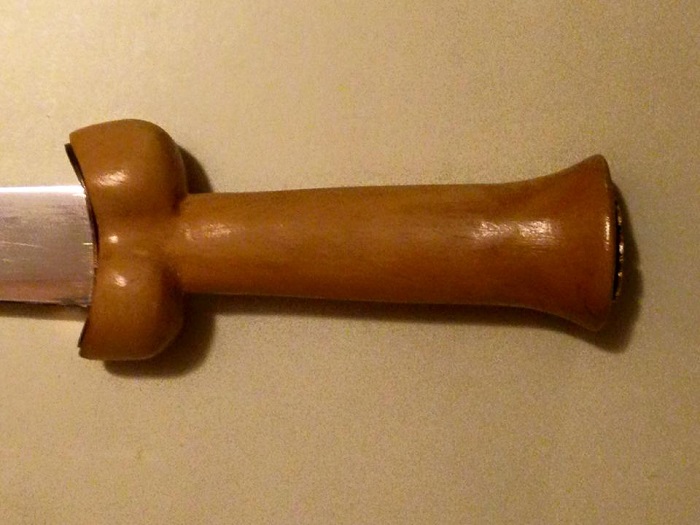
.jpg.c41ac782348d43e876a82062f151c370.jpg)
